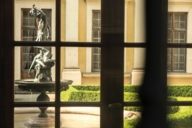
The myth of Ludwig II and his adoration of the French rulers of absolutism are legendary. However, Electress Henriette Adelaide of Savoy brought the splendour of France and Italy to the Munich court even before that in the 17th century. A report.
This glorious era came about thanks to Henriette Adelaide Maria of Savoy, Princess of Savoy-Piedmont. She came from a kingdom that stretched from Lake Geneva to the Mediterranean Sea, ruled by her mother, Christine of France. Christine, in turn, was the daughter of the French King Henry IV and Maria de Medici, a powerful female figure from Florence.
Adelaide grew up in the court of Turin with a perfectly harmonious background of dolce vita and savoir vivre: her mother’s main interests were ballet, Parisian styles of painting, and the promotion of French architecture in Italy. She also strove to marry Adelaide to Louis XIV, the Sun King himself, though her efforts were in vain. In the end, her daughter married Ferdinand Maria of Bavaria.
Adelaide and Ferdinand tied the knot in 1650. Before the marriage took place, Ferdinand’s father Maximilian I, Elector of Bavaria, sent a spy to Turin.
Adelaide and Ferdinand tied the knot in 1650. Before the marriage took place, Ferdinand’s father Maximilian I, Elector of Bavaria, sent a spy to Turin to report on his prospective daughter-in-law’s looks: Ferdinando Egartner (alias Aloise Rizzi) told him of Adelaide’s legendary beauty, and it was a done deal. When Maximilian I died just one year later, the 15-year-old Ferdinand became heir to the throne – and Adelaide became Electress of Bavaria.
The Princess journeyed from Turin with an entourage of 336 horses, 350 coaches of luggage and a medium-sized army of servants. The wedding took place on 25 June 1652 in the court chapel. Then a special age began for Munich: a phase of almost megalomaniacal italo-francophile splendour. This was because Adelaide curated the Munich court as a second Turin – in other words, she transformed it into a mini-Versailles.
A phase of almost megalomaniacal italo-francophile splendour. This was because Adelaide curated the Munich court as a second Turin – in other words, she transformed it into a mini-Versailles.
Dazzling parties, high society and an inimitable cultural transfer from France and Italy took hold in Munich. In the Residenz palace, which was still the largest city centre palace in Germany, Adelaide immortalised herself through the Parisian-style renovations she commissioned. She brought High Baroque, the comedy and Italian opera to the Bavarian capital. It was under her auspices that the Theatinerkirche (Theatine Church) and Schloss Nymphenburg (Nymphenburg Palace) came into being, the latter modelled on a Piedmontese hunting lodge with French-style gardens.
She also succeeded in creating a spectacle worthy of the Sun King himself at the Starnberger See (Lake) – or the Würmsee, as it was then known. In honour of the birth of her son and the heir to the throne, Max Emanuel, she commissioned the construction of a huge ship, 29 metres long and over eight metres wide, dripping with over-the-top ornamentation and based on the Doge of Venice’s state barge. This highly ornate vessel was decorated with paintings of dolphins and mermaids. The bucentaur, as it was known, was a floating hunting lodge from which those on board shot at herds of deer driven to the lake especially for the occasion. After party.
Adelaide’s devout Catholicism appears somewhat incongruous with this life of pomp and splendour, but only at first glance – it was an early form of the cosmopolitan glamour she lived out on numerous city trips with Ferdinand and their retinue. The pair had an audience with the Pope in Rome, swore a blood oath in Altötting, built their own Adelaide well in Heilbrunn and founded a highly obscure “Order of the Servants of the Mother of God”, which disappeared into the annals with the death of Adelaide in 1676.
Thanks to Adelaide, Munich is the northernmost city of Italy, the easternmost city of France and the only city in Germany that does not see any contradiction in these titles.
Adelaide died of a chill, which she caught while saving her children, barefoot, from a devastating fire that broke out in the Residenz palace one night, and from which she never recovered However, her legacy is immortal. Thanks to Adelaide, Munich is the northernmost city of Italy, the easternmost city of France and the only city in Germany that does not see any contradiction in these titles.
Also interesting: Castles in and around Munich